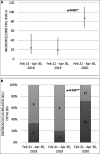Unexpectedly High Frequency of Enterococcal Bloodstream Infections in Coronavirus Disease 2019 Patients Admitted to an Italian ICU: An Observational Study
- PMID: 33122577
- PMCID: PMC7737701
- DOI: 10.1097/CCM.0000000000004748
Unexpectedly High Frequency of Enterococcal Bloodstream Infections in Coronavirus Disease 2019 Patients Admitted to an Italian ICU: An Observational Study
Abstract
Objectives: We aimed to assess the frequency of ICU-acquired bloodstream infections in coronavirus disease 2019 patients.
Design: Retrospective observational study.
Setting: The emergency expansion of an ICU from eight general beds to 30 coronavirus disease 2019 beds.
Participants: Patients with coronavirus disease 2019 admitted to the ICU of Luigi Sacco Hospital (Milan, Italy) for greater than or equal to 48 hours between February 21, 2020, and April 30, 2020.
Interventions: None.
Measurements and main results: The frequency of bloodstream infections per 1,000 days of ICU stay was calculated in 89 coronavirus disease 2019 patients, and the cumulative probability of bloodstream infection was estimated using death and ICU discharge as competing events. Sixty patients (67.4%) experienced at least one of the 93 recorded episodes of bloodstream infection, a frequency of 87 per 1,000 days of ICU stay (95% CI, 67-112).The patients who experienced a bloodstream infection had a higher Sequential Organ Failure Assessment score upon ICU admission (9.5; interquartile range, 8-12 vs 8, interquartile range, 5-10; p = 0.042), a longer median ICU stay (15 d; interquartile range, 11-23 vs 8, interquartile range, 5-12; p < 0.001), and more frequently required invasive mechanical ventilation (98.3% vs 82.8%; p = 0.013) than those who did not. The median time from ICU admission to the first bloodstream infection episode was 10 days. Gram-positive bacteria accounted for 74 episodes (79.6%), with Enterococcus species being the most prevalent (53 episodes, 55.8%). Thirty-two isolates (27.3%) showed multidrug resistance.
Conclusions: Coronavirus disease 2019 seemed to increase the frequency of bloodstream infections (particularly Enterococcus-related bloodstream infection) after ICU admission. This may have been due to enteric involvement in patients with severe coronavirus disease 2019 and/or limitations in controlling the patient-to-patient transmission of infectious agents in extremely challenging circumstances.
Copyright © 2020 by the Society of Critical Care Medicine and Wolters Kluwer Health, Inc. All Rights Reserved.
Conflict of interest statement
Dr. Giacomelli received funding from consultancy fees from Mylan and educational support from Gilead. Dr. Antinori has received support for research activities from Pfizer and Merck Sharp & Dome. The remaining authors have disclosed that they do not have any potential conflicts of interest.
Figures



References
-
- Wu Z, McGoogan JM. Characteristics of and important lessons from the coronavirus disease 2019 (COVID-19) outbreak in China: Summary of a report of 72 314 cases from the Chinese Center for Disease Control and Prevention. JAMA. 2020; 323:1239–1242 - PubMed
-
- Grasselli G, Pesenti A, Cecconi M. Critical care utilization for the COVID-19 outbreak in Lombardy, Italy: Early experience and forecast during an emergency response. JAMA. 2020; 323:1545–1546 - PubMed
-
- Horan TC, Andrus M, Dudeck MA. CDC/NHSN surveillance definition of health care-associated infection and criteria for specific types of infections in the acute care setting. Am J Infect Control. 2008; 36:309–332 - PubMed
Publication types
MeSH terms
LinkOut - more resources
Full Text Sources
Medical
Miscellaneous

